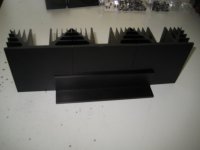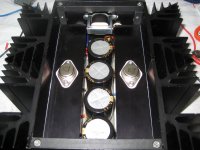Hello WalterW. Your build of CSX1 is a professional masterpiece. It speaks about your creativity, will and ability to materialize this beauty. The following are possible thoughts which may explain your perceptions. I maybe off; but I always try to make reasonable connections.Took me some days to answer this😀 And I don't have golden ears....
The CSX1 sounds warm, fluid en very musical, but every time I switch from VFET to F5Tv3, I am surprised that the F5T has it all too. F5T maybe sounds a bit flatter, but more precise. They do sound different, I can hear that🙂
BTW: The P3 trimpot for playing with harmonics in the F5T is still untouched, in the middle position.
Curious for reviews of others, who can better describe what they hear...
Walter
1. A difference between CSX1 and F5T is their output impedance; ~4 Ohms for CSX1 and ~0 Ohms for F5T. This variation will cause a different damping of the woofer in the common loudspeaker you used to compare the amps; thus affecting sound.
2. Take F5T and disable its feedback loop. The resultant amp is a current source amp of high output impedance; a guess maybe 25 Ohms. Its characteristics are pentode-like; meaning a voltage [at input] controls a current source [at output]. Closing the feedback loop reminds me of Schade feedback used in vacuum tubes which had the specific objective to create a triode characteristic from that of a pentode vacuum tube. Like Schade, feedback in F5T emanates from its high output impedance node [opposed drains of output Mosfets] to its front-end's summing junction. This Schade or [I like to call it Pass-style for semis circuits] feedback now infuses F5T with triode-like behavior; or makes it a voltage controlled variable resistor. My hypothesis! is that F5T maybe be considered and thus sings as a simulated SIT.
3. I recall [vaguely] the 6moons review of F6 that is sonics were like that one of the Pass SIT amps which was tested during the same time frame. Feedback in F6 is like that in F5T; meaning a hypothetical Schade or Pass-style to make another simulated SIT amp.
Best regards
Yes.
Are you kidding me?! No Aluminum oxide insulators for TO-3 case?! Only ancient mica... :-(
Are you kidding me?! No Aluminum oxide insulators for TO-3 case?! Only ancient mica... :-(
Nahh, they exist, i have some of them =)
I just made a quick ebay-search on "to-3 ceramic" and found some there.
I would buy the thicker ones because when i bought the thinnest Al2O3 TO-3 insulators they were not as flat as i would have expected!
Got some thicker ones (maybe2-3mm) and they are very flat indeed. I think quality varies some with these TO-3 insulators.
Yes did not mean that there are none, but that it is completely unnecessary to spend a lot of money for aluminium oxide wafers. Mica insulators are good and cheap.
Look at Fischer Elektronik for aluminium oxide wafers: http://www.fischerelektronik.de/web_fischer/en_GB/heatsinks/E01.06/Aluminium%20oxide%20wafers/$search_result_naviActualPage/4/$search_result_naviLinesPerPage/5/search.xhtml#search_result_naviPage
Look at Fischer Elektronik for aluminium oxide wafers: http://www.fischerelektronik.de/web_fischer/en_GB/heatsinks/E01.06/Aluminium%20oxide%20wafers/$search_result_naviActualPage/4/$search_result_naviLinesPerPage/5/search.xhtml#search_result_naviPage
It's quit hot here in Holland, my room temperature is reaching 24C 😛
And my VFET transistors reach about 72C on top, is that long term OK?
I can listen few hours to it without problems, but I want to be sure that I'm not slowly destroying my VFETs. ( and probably my speaker woofer).
I have been thinking about reducing the temperature by putting an extra SK88 in between, it can be done quit easily with using the same backpanels and frontpanels.
Or is 72C just fine?
And my VFET transistors reach about 72C on top, is that long term OK?
I can listen few hours to it without problems, but I want to be sure that I'm not slowly destroying my VFETs. ( and probably my speaker woofer).
I have been thinking about reducing the temperature by putting an extra SK88 in between, it can be done quit easily with using the same backpanels and frontpanels.
Or is 72C just fine?
Attachments
more , the merrier
same for L one
I know..... but L one thicker than 40 x 40 x 5mm is very hard to find.
But I hope someone can answer with arguments, if 72C is acceptable for the VFET.... or not🙁
I know..... but L one thicker than 40 x 40 x 5mm is very hard to find.
But I hope someone can answer with arguments, if 72C is acceptable for the VFET.... or not🙁
WINKEL | ALUMINIUM | alu-verkauf.de GmbH
yes, I have searched similar shops in Holland, but in 40 x 40 it is max. 5mm.
For thicker I have to take a 50 x 50 x 8, but that's not gone work in my little monoblock:
Hi WalterW. You maybe the one who will answer the question regarding continuous operation at 72 Celsius; clearly with a potential risk to the health of the VFETs. Do you keep your system on all day or turn it on only to listen to it, and if so for how long? During its idle time if any, may consider a standby mode whereby the power rails are intentionally decreased for example to +/-15V by using a VARIAC; if that is a viable option.
I've used reuseable cold packs [hermetically sealed from CVS Pharmacy] on small heat sink fins to protect high dissipating semis. It was an effective and quiet bandaid remedy; but with regular trips to the cold box of the refrigerator to fetch other refreshing cold packs. You'll be able to profile the impact of this cooling method since you already measure temperature. And will also temporarily allay you fears.
I know..... but L one thicker than 40 x 40 x 5mm is very hard to find.
But I hope someone can answer with arguments, if 72C is acceptable for the VFET.... or not🙁
I would say no at running the case (Tc) @ 72C. What is the bias, 1.2A? 1.2A@24v Drain-Source is almost 30W dissipation.
I have no idea what the thermal resistance is from junction to case but would guess about 1K/W form a rather old device like this.
This means that your VFET/SIT die would be at 102C (if Tj-Tc is 1K/W) as an estimate. I would not run a semiconductor at that temp for any long time. No 24/7 if you want it to last long and be reliable imo.
These are 90 watt parts, probably with an internal thermal resistance of 1.5
deg/watt, and a 150+ deg junction rating.
At 72 deg on the case, the max dissipation would be about 40 watts.
😎
deg/watt, and a 150+ deg junction rating.
At 72 deg on the case, the max dissipation would be about 40 watts.
😎
Read the article a little more in detail and see that Id is 1.5a at 24v Drain-Source, so 36W dissipation then. If Tj-Tc is ~1.5 K/W that makes the die temperature at estimate 126C if the SIT case is at 72C.
I don't know but the datasheet says Tj max is 120C. I would not sleep happy even if the datasheet said Tj max = 150C if the die temp was ~126C.
But it would be nice to know how long the SIT would work @ 126C Tj in a setup running 24/7 🙂
I don't know but the datasheet says Tj max is 120C. I would not sleep happy even if the datasheet said Tj max = 150C if the die temp was ~126C.
But it would be nice to know how long the SIT would work @ 126C Tj in a setup running 24/7 🙂
I know..... but L one thicker than 40 x 40 x 5mm is very hard to find.
But I hope someone can answer with arguments, if 72C is acceptable for the VFET.... or not🙁
what I meant - make L heat spreader long as heatsinks ; 40x40x5 is , say , good enough
then , if needed , make baby-sitter for amps , if temp is still higher then 50C on heatsink
yup - 70C is too much , be it on TO3 case ......... or heatsink (even worse)
Last edited:
About the L bracket what about using 2 of the 40 X 5 connected back to back to make a T shaped bracket this would also spread the heat on the heatsink a lot more. True it would take a lot of heatsink compound .....
Now as a public apology. I have some berlinium oxide TO3 insulators i don't need and offered them before but they probably come under the catagory of hazardus materials so I can't bring myself to ship them out of the USA. I just am not going to do that and put my name on the customs form. I offered them before but the only 2 people who wanted some were overseas and I never got back with them ( I kept thinking about the customs form and puting it off ect. ) But anyone building this here in the U.S.A. and just need a few let me know I have nothing in them they were almost given to me. By the way these break easy don't over tighten them.
Now as a public apology. I have some berlinium oxide TO3 insulators i don't need and offered them before but they probably come under the catagory of hazardus materials so I can't bring myself to ship them out of the USA. I just am not going to do that and put my name on the customs form. I offered them before but the only 2 people who wanted some were overseas and I never got back with them ( I kept thinking about the customs form and puting it off ect. ) But anyone building this here in the U.S.A. and just need a few let me know I have nothing in them they were almost given to me. By the way these break easy don't over tighten them.
Dynamic Class A biasing for CSX1!
I wonder whether this amp will be amenable for dynamic class A biasing; so as to minimize thermal stresses. Mr. Pass is expert in this field, and may consider guiding DIYers with a concept schematic to do so, which will be appreciated.
I wonder whether this amp will be amenable for dynamic class A biasing; so as to minimize thermal stresses. Mr. Pass is expert in this field, and may consider guiding DIYers with a concept schematic to do so, which will be appreciated.
- Status
- Not open for further replies.
- Home
- Amplifiers
- Pass Labs
- Article - Sony VFETs part 1

